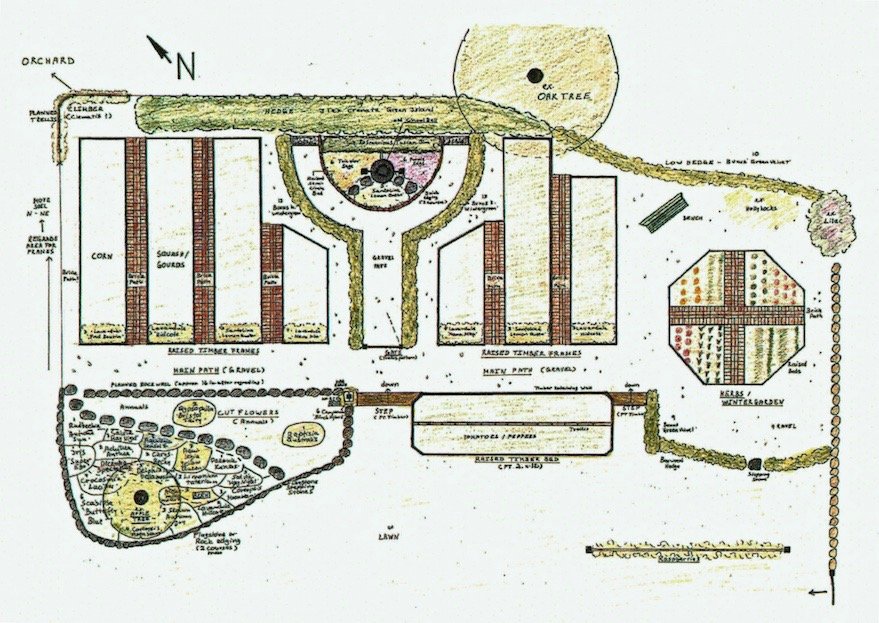Edible Gardens & Potagers
Edible gardens have become deservedly popular. They can consist of several raised garden beds, have their own separate plot, or be incorporated within the ornamental plantings. The French Potager is a more extensive kitchen garden with a designed layout and additional aesthetic features. A greenhouse may be included as well. Newer berry and vegetable cultivars are increasingly valued for their ornamental as well as their culinary merits. Cut flowers may also be part of the edible garden.
Design Considerations
-
Edible gardens can be an outstanding, decorative asset to your landscape, as well as producing delicious, organic produce and fruit. Every landscape can include edible plants, with many heirloom and new varieties readily available. They are best combined with texture interest and contrasting color in mind, in addition to their culinary properties. Vegetables come in ranges of blue-green, red and bright green leaf colors. Various herbs and aromatic perennials and shrubs, such as Lavender, can be included. You may also wish to plant annuals and perennial cut flowers. And hen houses and chickens can be integrated too. Edible gardens perform well in the Mid-Columbia, with its abundant sunshine during the summer months. Sheltering the garden from strong winds and choosing the correct varieties according to the site’s elevation are considerations.
-
A potager is a structured ornamental vegetable garden, its beds often designed formally in repetitive, geometric patterns. A potager has year-round visual appeal. A series of paths connect the beds, wide enough for comfortable garden work and comfortable to walk on.
-
Raised beds lend themselves to the edible garden style. They produce earlier and abundant crops, especially if filled with the right soil mix. We prefer rough-cut cedar 2×4 lumber as a building material for these beds. Wood plastic composite materials such as Trex or TimberTech are also an option, as are COR 10 metal or stone. 2×8 or 2×10 top boards double as sitting ledges, also allowing for comfortable gardening. Trellises attached to the back or center of raised beds offer support for tomatoes or climbing vegetable plants, and add ornamental appeal.
-
Edible gardens may be partially or fully surrounded by a low hedge or fence, lending privacy and creating a delightful garden space. Boundary plants may be shrub roses, ornamental shrubs or edible plants. Berry plants such as Blueberries, Red Currants or trellised Raspberries can be used as background or enclosure shrubs, being ornamental as well as edible. Blueberry leaves display vibrant red fall color as an added bonus. With the selection of several different Blueberry cultivars, harvest can last over two months.
If deer are present, edible gardens need to be surrounded by an at least 8 feet high fence, e.g. wire mesh or Polypropylene Deer Control Fence.
-
Fruit trees may be espaliered. In Hood River County, with its major fruit industry, fruit trees in home gardens need to be sprayed, to prevent them from acting as hosts for insects such as Codling Moth, which could infest commercial orchards.
-
Your edible garden can contain decorative and supporting vertical elements such as fences, trellises, obelisks and arches. Sculpture, birdbaths, and containers form focal points and add interest. You may even wish to build a small greenhouse or cold frame, extending the growing season and raising your own vegetable starts.
-
Raising female chickens for egg production has become popular. Liberal literature is available on the subject. In general, 12 chickens seem to be a good number for a medium-sized household. Ideally, each chicken needs 4 square feet of outdoor run, plus a nest box and perch in an indoor space. 2 to 3 square feet of indoor space per hen is recommended. Generally, the chicken coop is not insulated. The hen house can be designed as a decorative building, mirroring features of a nearby home or barn, therefore linking the two. A movable Chicken Tractor is also an option.
Design for the Potager
The implemented potager design, still going strong thirteen years later, The Dalles
This L-shaped Cedar raised bed and the trellis furnish ample vegetable growing space
Kitchen garden at Sakura Farm and Lodge. The raised beds were constructed out of rough-cut cedar, surrounded by bluestone squares creating a mowing edge
Small raised bed in an urban back landscape, Hood River. The top board doubles as a seating ledge
This contemporary garden contains numerous edible plants, among others espaliered three-way apple trees, functioning as a living fence







